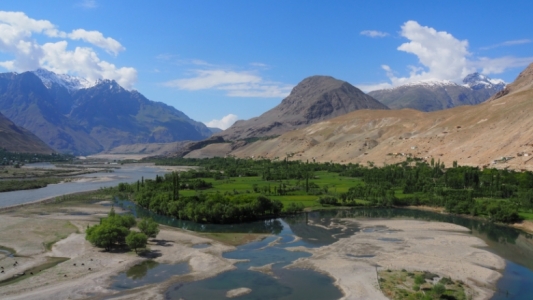Bringing Clean Energy and Co-Benefits to Remote Communities in Tajikistan and Afghanistan with AKFED 2021-02-04
Overview
This case study shows how clean, affordable and reliable electricity can be provided to thousands of people even in the poorest, most remote and difficult terrains. It illustrates how this simultaneously reduces energy poverty and carbon emissions while generating multiple co-benefits, including increased incomes, improved food security and community well-being, reduced deforestation, improved health from removing smoke from biofuels from homes, and improved healthcare and educational outcomes.
EXECUTIVE SUMMARY
After the collapse of the Soviet Union (USSR) in 1991 and the ensuing five-year civil war, Tajikistan’s electricity infrastructure was left in a weak state. The Gorno-Badakhshan Autonomous Oblast (GBAO), also known as Viloyati Mukhtori Kuhistoni Badakhshon (VMKB), is a remote mountainous area in the Pamir Mountains in the east of the country, bordering Afghanistan, China and the Kyrgyz Republic. VMKB is Tajikistan’s largest region, making up 47% of the country’s area, and also the poorest, with 54.5% of its population living below the poverty line.
The region is one of the worst affected by poor infrastructure, and large parts of it are not connected to the Tajik national grid. Only 13% of the population of 220,000 in VMKB in 2002 (4% of the total population) had access to electricity before the Pamir Energy company was established (Ashden, 2017). In winter people suffered as they were unable to heat their houses, schools, health centres and businesses. Many people used wood fuel, kerosene or animal dung to heat their homes and to cook; as a result, smoke inhalation led to respiratory illnesses, and 70% of the region’s forests were destroyed in less than 10 years following the collapse of the USSR (Ibid.).
In the 1990s the Government of Tajikistan struggled to maintain existing electricity services and could not provide or attract the investment needed to upgrade the hydropower network bequeathed by the USSR (World Bank, 2011). In December 2002, a private public partnership (PPP) was established through a concession agreement signed between Aga Khan Fund for Economic Development (AKFED), an arm of the Aga Khan Development Network (AKDN), and the Government of Tajikistan.
Under the terms of the PPP, the Government of Tajikistan granted a 25-year concession to Pamir Energy, a private company and subsidiary of AKFED, to supply power to the VMKB area until 2027 (Jumaev, 2018).
Pamir Energy is responsible for developing, maintaining and operating all energy infrastructure and assets within the concession area of Viloyati Mukhtori Kuhistoni Badakhshon (VMKB), which it will transfer back to the government at the end of the concession in 2027. AFKED has a 70% controlling share of the company. Other international bodies have provided finance, grants and technical assistance at different stages of the project.
In the first phase, between 2002 and 2012, $37m was invested to repair and upgrade electrical infrastructure and to expand generation capacity in the VMKB region. Eleven small and medium hydropower plants and 4,300km of old transmission and distribution lines were repaired (Ashden, 2017). Most of the micro hydropower plants were restorations or upgrades of Soviet-era plants that had either stopped working or were only partially working. Eight of the plants are linked to Pamir Energy’s main grid and three are linked to micro-grids. The project has provided 96% of households in the area with reliable, clean and affordable energy and has reduced both harmful smoke inhalation and deforestation (Ashden, 2017), and also helped schools and hospitals to purchase heaters in 2015 (Pamir Energy Communication, 2020). The company is currently implementing a hybrid model of hydro, solar and wind energy options to bring electricity to the remaining 4% of the population in the VMKB region (Jumaev, 2018; Price and Hakimi, 2019).
In the second phase of the project, from 2012 onwards, partnerships with and funding from a number of international bodies provided funding that allowed Pamir Energy to expand the network in VMKB and also extend transmission lines across the Panj River into Shugnan District in northern Afghanistan (Taylor, 2017). The Shugnan District is split between Tajikistan and Afghanistan. In 2016, clean and affordable electricity was transmitted to nearly 3,000 people in the communities of Deshor and Wiriz in this part of the Badakhshan Province, many of whom had never had access to electricity before. Pamir Energy also improved the availability of clean, affordable and reliable electricity for another 20,000 people in Afghanistan. In total it serves just over 41,000 people in Northern Afghanistan through the cross-border projects which now also extend into Ishkashim, Maimai, and Nusai districts.
Concessional grants from the Swiss government and the International Development Association (IDA) have enabled electricity to be provided at subsidized rates to low-income households. In 2016, the government of Tajikistan began providing subsidies rather than international donors (Personal Communication, 2020, Pamir Energy personnel).
- 1670 reads
 Ismaili.NET - Heritage F.I.E.L.D.
Ismaili.NET - Heritage F.I.E.L.D.